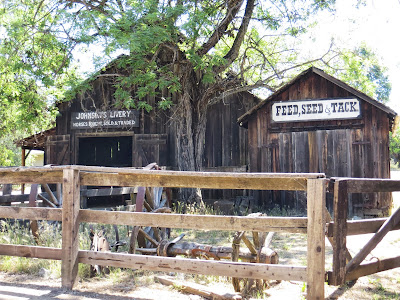Today, we made the trek down the mountain. Our destination was the Columbia State Historic Park which has preserved the town's old Gold Rush-era business district with shops, restaurants, and two hotels.
We arrived about 10:30 and found out there would soon be a walking tour. We went through the museum and we were ready to begin the tour. At first it was just Jim and I, then we were joined by several families. The tour was led by a California Park Ranger who was extremely informed on the town's history.
He began by telling us about how much miners found a day in gold, usually about $10, but they were not able to keep all of that. There were quite a few expenses, the biggest one being water for them to mine placer gold (mining for gold by sifting through the sand or gravel). Many became discouraged and left, but many others stayed with the hope of striking pay dirt.
There were many stories of overnight riches and overnight losses.
A stagecoach came in while we were at the Wells Fargo Building. You can purchase tickets to ride the stagecoach.
Since we were on the walking tour, we were able to go inside the building.
This was the place that had the best reputation for paying a fair price for gold. Miners would line up for blocks to wait to trade in their gold for money. They were also able to pick up mail and packages here as well.
Another building we visited was the Volunteer Fire Department. In 1854, fire destroyed everything in the Columbia business district except for one brick building. When the town was rebuilt, locally produced red brick was used for thirty buildings. In 1855, the New England Water Company provided piped water for firefighting and domestic use. Seven cisterns, each with a capacity of about fourteen thousand gallons, were build under the streets.
In 1857, another fire destroyed all the frame structures in the 13-block business district, as well as several of the brick buildings. This time the citizens decided to form a volunteer fire department. In 1859 the fire department acquired the Papeete, a small fancifully decorated fire engine. We were told that this was originally intended for a King in the Tahitian Islands, but as it was being shipped by freighter, the crew jumped boat in order to mine. The fire engine went to San Francisco and was then purchased by the people in Columbia. On either side of the high frame, above the body of the engine were "splendidly executed Sandwich Island angels, something like the complexion of a new saddle." There was concern as to what the Columbians would think of these nude bathing figures and so "nice screens fitted over them."
The engine is still in working order.
Our last stop was the general store which has been restored to its original condition. The items in the store are reproductions. By the time we had finished our tour, it was just Jim and I. The kids in the group could only last so long and our guide had told everyone in advance, if you needed to leave early, that was fine.
The tour was a wonderful way to find out about the history of another gold mining town.
On our way out, we stopped at this bowling alley where families were able to bowl down the lane, then set their wooden pins back up.
Columbia State Historic Park was another great place to visit.










No comments:
Post a Comment